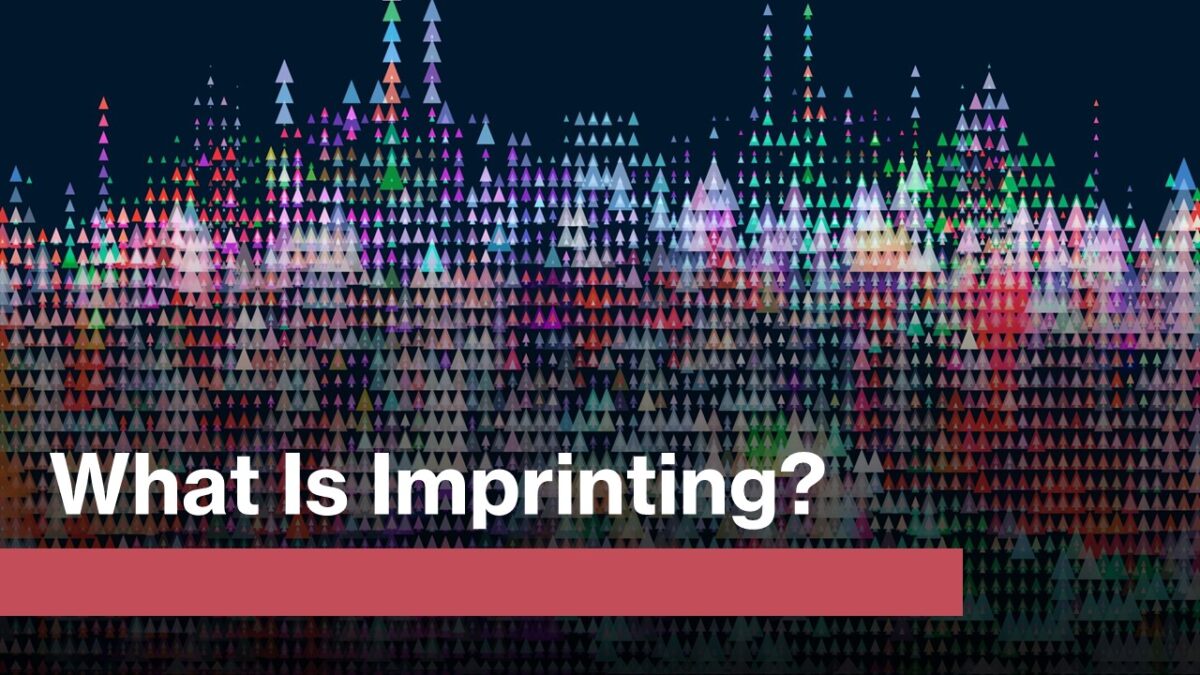Generally, imprinting (linguistically, it is a derivative of “printing”) means marking or impressing a sign or mark on the surface of anything.
Imprinting in Ethology
In ethology, the science of animal behavior, imprinting stands for a sensitive period, usually very early in the life of an animal, when instant or fast learning occurs. It is a time in which newborn animals form attachments to members of their own species. Imprinting has been used to domesticate animals and birds for generations.
A typical example of imprinting is when ducklings follow their mother duck, which they see moving within a few hours after they hatch. Young ducks tend to imprint and follow their mother duck. They also imprint the first individual of their species that they interact with during this ‘sensitive’ period of biological development. The same way they would imprint on and follow any first large object they see moving. This is how their love for and attachment to “mother” is forming. They become attracted to the movement, sound, and smell of the first-appearing object in their life.
The science of imprinting can explain “Who is your mama?”
What are the functions of imprinting in love attraction and love attachment? How can imprinting affect our kinship, mating relationships, and love?
Does Imprinting Form an Infant’s Attachment and Love Bonds of Kinship?
Imprinting seems to allow animals to instinctively recognize other animals of their own species, thus developing a model of their species’ “identity.” This identity naturally drives their attraction to their “mother”, “kin”, and others of the same kind. We can view this attraction as an animal’s early prototype of infants’ love bonds with their species’ kin.
Konrad Lorenz, an Austrian naturalist, ornithologist, and ethologist, discovered and first investigated the phenomenon of “imprinting” in the early 1900s (see for review, Bateson, 1978; Hess, 1958; Lorenz, 1935; Tzschentke & Plagemann, 2006).
Lorenz revealed that when young birds—little ducks or geese—came out of their eggs, they became attached to the first moving object they encountered. It is typically their mother. Natural selection prepared the hatchlings to form an instant and strong bond with their mother. We can consider this effect as an early form of “attachment love”—the loving attachment of an infant to a mother.
However, when Lorenz placed himself as the object of their attraction (instead of their mother), the young birds attached to him as a mother substitute. Working with ducks and geese, Lorenz showed evidence that such attraction and attachment happen during sensitive periods in their lives. Once such attraction and attachment were ‘fixed,’ they persisted for a long time. Geese responded to Lorenz as a parent and followed him about everywhere. When they became adult birds, they preferred to court him over other geese.
The same way, they would easily attach to any inanimate object, such as a white ball, a pair of gumboots, or even an electric train. The most crucial aspect of such attachment is that these objects appear at the appropriate time.
Does Imprinting Affect an Animal’s Sexual Love for Its Own Species?
Those early imprinting studies revealed that early imprinting forms not only family love bonds but also sexual preferences in mating. This can explain why animals do not mate with any other animals except those of their own species. From an evolutionary perspective, genetic similarity is vital for sexual attraction and mating in birds and mammals. Such mating preferences help select the proper mate. They cannot reproduce offspring with anyone. They can only do this with those with whom they have a higher chance of mating success than with others (Lampert 1997).
Birds and mammals cannot mate with animals of other species. They are genetically too distant to produce offspring. This mechanism explains the genetic secrets of attraction and love.
Let us consider the example of sexual imprinting among birds. Early works by Konrad Lorenz demonstrated that the early experiences that birds and animals have in their lives could significantly affect not only their “kinship” bonds. Such an early imprinting experience could also form their mating preferences and their love for each other. Lorenz suggested that sexual imprinting gives adults a predilection to recognize their own species (Lorenz, 1935).
Lorenz found that geese responded to him not only as parents, following him everywhere, but later in their lives, when they became adult birds, they preferred to court him rather than other geese.
Here Are More Complex Effects of the Imprinting
Experimental studies of the mid-20th century supported early findings on imprinting. The early experiences of animals can certainly have long-lasting impacts. Nonetheless, those later studies indicated that birds may show their preferences for members of their own species even if they don’t have experience with any of them except themselves (Immelmann, 1969; Schutz, 1965).
This means that birds may have a predisposition for their own species without prior experience. But the early years’ sexual imprinting merely refines this predisposition under natural conditions.
Another explanation suggests that sexual imprinting plays a role in the recognition of close kin. This way, the selection of mates that are slightly different allows the animal to reach an optimal balance between inbreeding and outbreeding. Birds have the strongest mating preference for
“something a little different (but not too different) from the object with which it had been imprinted.”
(Bateson, 1978, p. 659).
The studies found that a bird does indeed mate with a slightly unfamiliar female. The bird prefers this unfamiliar female to the one that appeared in the early life of the bird. Nevertheless, the bird prefers both types of these females to those with a markedly unfamiliar type of plumage (Bateson, 1978).
These findings show the power of genetic similarity and genetic diversity in attraction and attachment.
